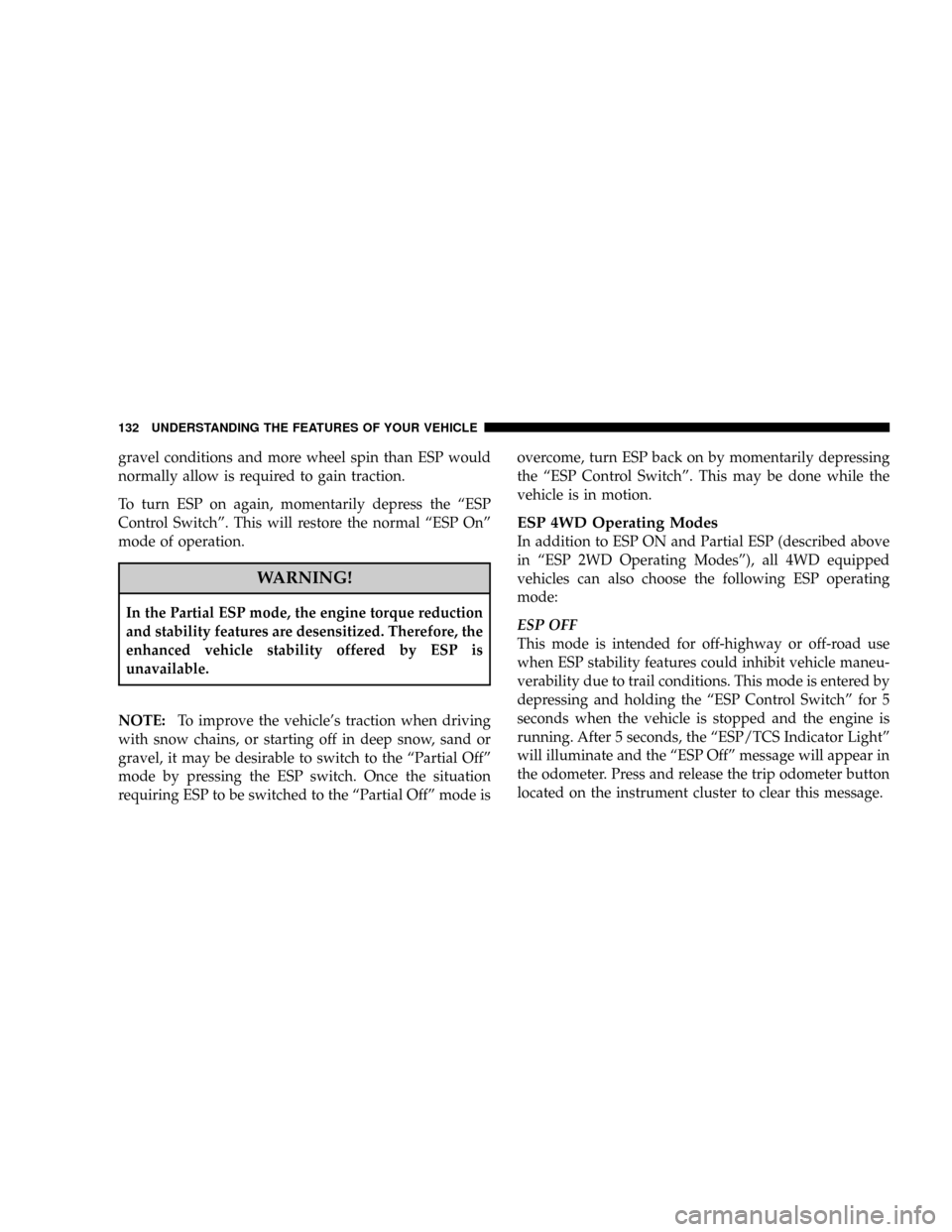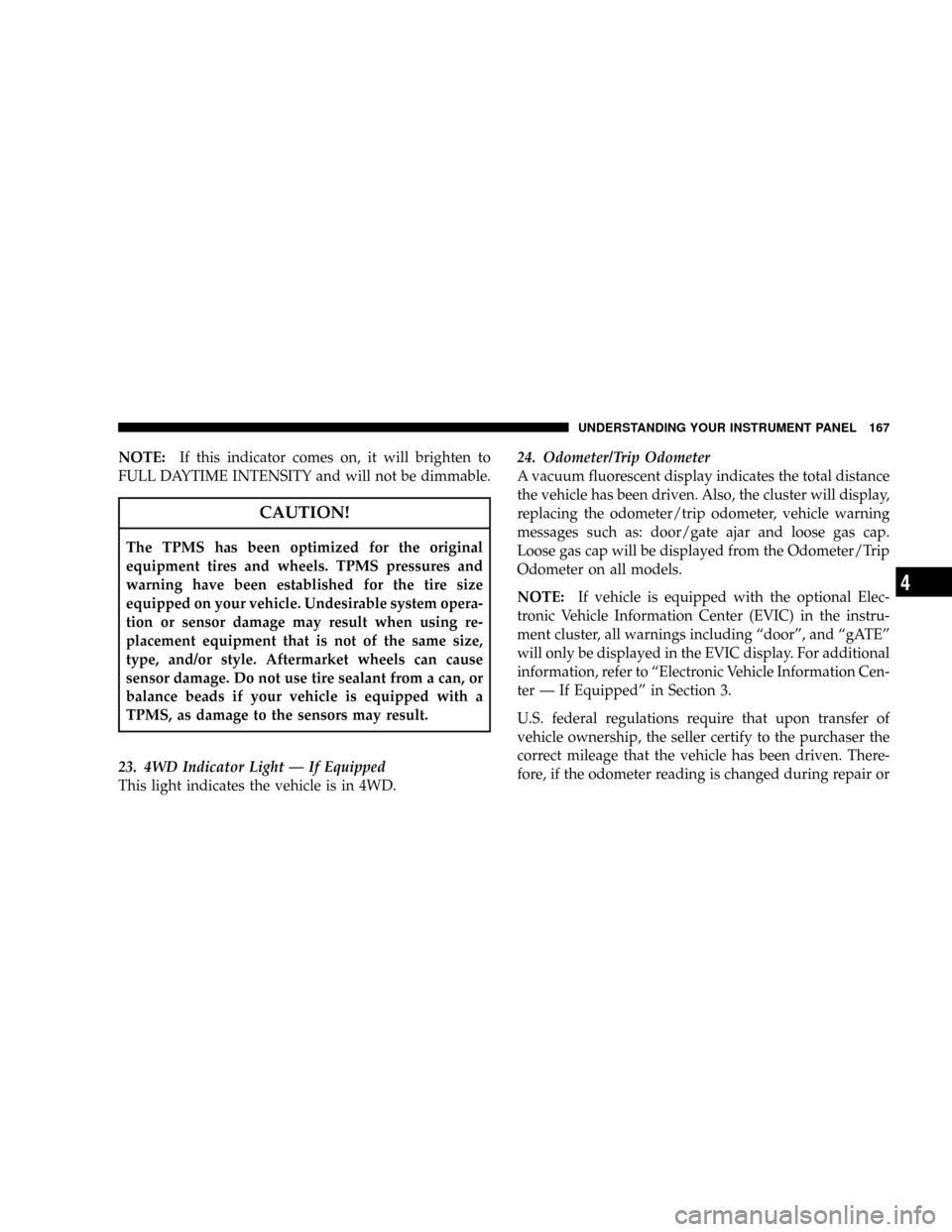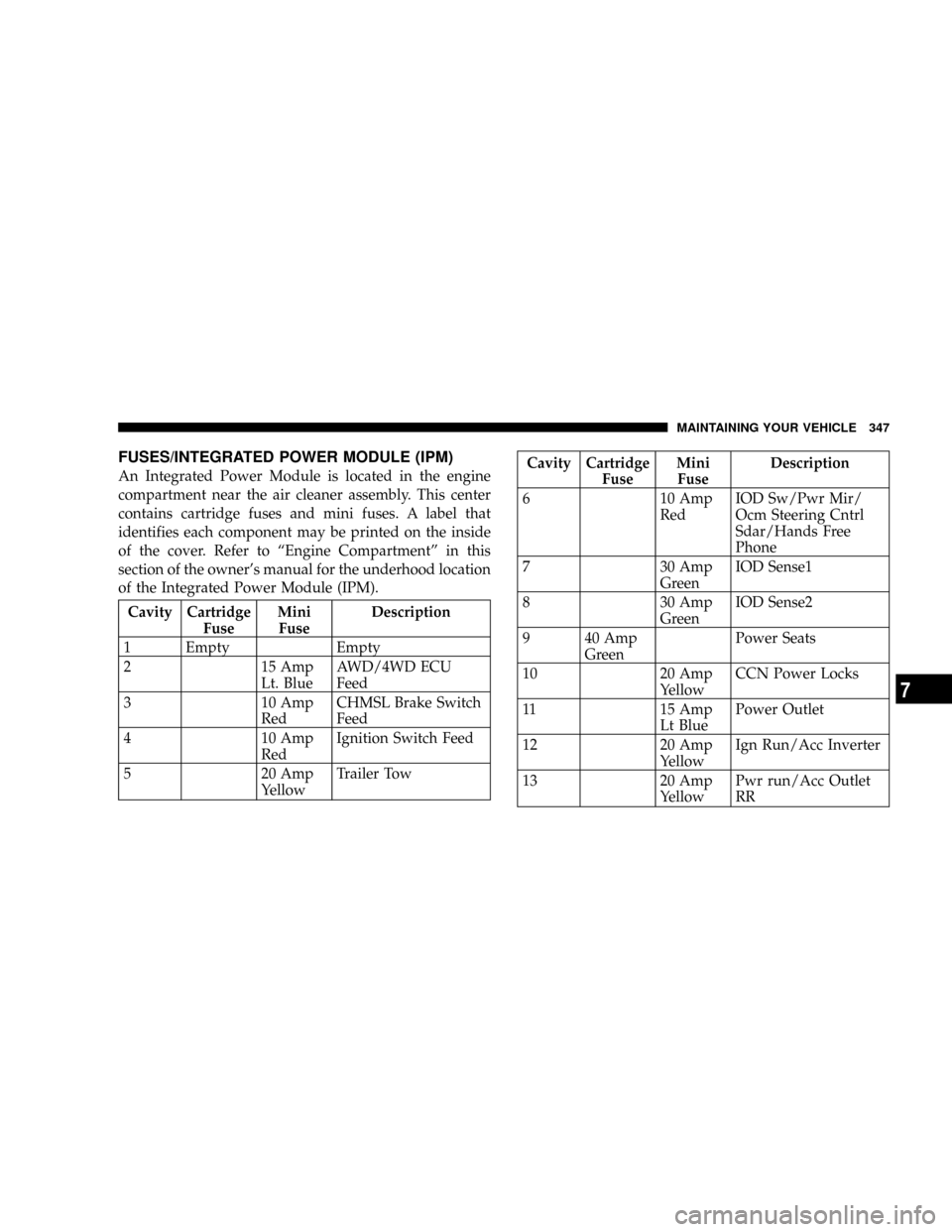4WD JEEP COMPASS 2008 1.G Owners Manual
[x] Cancel search | Manufacturer: JEEP, Model Year: 2008, Model line: COMPASS, Model: JEEP COMPASS 2008 1.GPages: 399, PDF Size: 6.59 MB
Page 132 of 399

gravel conditions and more wheel spin than ESP would
normally allow is required to gain traction.
To turn ESP on again, momentarily depress the ªESP
Control Switchº. This will restore the normal ªESP Onº
mode of operation.
WARNING!
In the Partial ESP mode, the engine torque reduction
and stability features are desensitized. Therefore, the
enhanced vehicle stability offered by ESP is
unavailable.
NOTE:To improve the vehicle's traction when driving
with snow chains, or starting off in deep snow, sand or
gravel, it may be desirable to switch to the ªPartial Offº
mode by pressing the ESP switch. Once the situation
requiring ESP to be switched to the ªPartial Offº mode isovercome, turn ESP back on by momentarily depressing
the ªESP Control Switchº. This may be done while the
vehicle is in motion.
ESP 4WD Operating Modes
In addition to ESP ON and Partial ESP (described above
in ªESP 2WD Operating Modesº), all 4WD equipped
vehicles can also choose the following ESP operating
mode:
ESP OFF
This mode is intended for off-highway or off-road use
when ESP stability features could inhibit vehicle maneu-
verability due to trail conditions. This mode is entered by
depressing and holding the ªESP Control Switchº for 5
seconds when the vehicle is stopped and the engine is
running. After 5 seconds, the ªESP/TCS Indicator Lightº
will illuminate and the ªESP Offº message will appear in
the odometer. Press and release the trip odometer button
located on the instrument cluster to clear this message.
132 UNDERSTANDING THE FEATURES OF YOUR VEHICLE
Page 167 of 399

NOTE:If this indicator comes on, it will brighten to
FULL DAYTIME INTENSITY and will not be dimmable.
CAUTION!
The TPMS has been optimized for the original
equipment tires and wheels. TPMS pressures and
warning have been established for the tire size
equipped on your vehicle. Undesirable system opera-
tion or sensor damage may result when using re-
placement equipment that is not of the same size,
type, and/or style. Aftermarket wheels can cause
sensor damage. Do not use tire sealant from a can, or
balance beads if your vehicle is equipped with a
TPMS, as damage to the sensors may result.
23. 4WD Indicator Light Ð If Equipped
This light indicates the vehicle is in 4WD.24. Odometer/Trip Odometer
A vacuum fluorescent display indicates the total distance
the vehicle has been driven. Also, the cluster will display,
replacing the odometer/trip odometer, vehicle warning
messages such as: door/gate ajar and loose gas cap.
Loose gas cap will be displayed from the Odometer/Trip
Odometer on all models.
NOTE:If vehicle is equipped with the optional Elec-
tronic Vehicle Information Center (EVIC) in the instru-
ment cluster, all warnings including ªdoorº, and ªgATEº
will only be displayed in the EVIC display. For additional
information, refer to ªElectronic Vehicle Information Cen-
ter Ð If Equippedº in Section 3.
U.S. federal regulations require that upon transfer of
vehicle ownership, the seller certify to the purchaser the
correct mileage that the vehicle has been driven. There-
fore, if the odometer reading is changed during repair or
UNDERSTANDING YOUR INSTRUMENT PANEL 167
4
Page 170 of 399

cycles, and the vehicle has been driven several miles at
speeds greater than 30 mph (48 km/h), see your autho-
rized dealer as soon as possible.
29. 4WD! Warning Light Ð If Equipped
This light monitors the Four -Wheel-Drive
(4WD) system. The light will come on, for a
bulb check, when the ignition key is turned to
the ON position and may stay on for as long as
3 seconds.
When lit solid:There is an 4WD system fault. 4WD
performance will be at a reduced level. Service the 4WD
system soon.
When blinking:The 4WD system is temporarily dis-
abled due to overload condition.30. Electronic Vehicle Information Center DisplayÐIf
Equipped
When the appropriate conditions exist, this display
shows the Electronic Vehicle Information Center (EVIC)
messages.
31. Electronic Vehicle Information Center (EVIC)
ButtonÐIf Equipped
Pushing this button, will change the display to the
choices available for EVIC.
170 UNDERSTANDING YOUR INSTRUMENT PANEL
Page 238 of 399

FOUR WHEEL DRIVE OPERATION Ð IF
EQUIPPED
This feature provides full time, on-demand, Four Wheel
Drive (4WD).
Where one or more wheels have wheel spin or if addi-
tional traction is needed in sand, deep snow, or loosetraction surfaces, activate the 4WD LOCK switch by
pulling up once and releasing. This locks the center
coupling allowing more torque to be sent to the rear
wheels. The amber94WD Indicator Lightº will come on
in the cluster. This can be done on the fly, at any vehicle
speed. To deactivate, simply pull on the switch one more
time. The94WD Indicator Lightº will then go out.
NOTE:Refer to ºESP (Electronic Stability Program) in
the ªElectronic Brake Control Systemº section of this
manual for additional information.
DRIVING ON SLIPPERY SURFACES
Acceleration
Rapid acceleration on snow covered, wet, or other slip-
pery surfaces may cause the front wheels to pull errati-
cally to the right or left. This phenomenon occurs when
there is a difference in the surface traction under the front
(driving) wheels.
Four Wheel Drive Switch
238 STARTING AND OPERATING
Page 310 of 399

NFront Suspension Ball Joints..............327
NBody Lubrication.....................327
NWindshield Wiper Blades................328
NWindshield Washer Reservoir.............328
NExhaust System......................328
NCooling System.......................329
NHoses And Vacuum/Vapor Harnesses.......335
NFuel System Connections................335
NBrake System........................335
NAutomatic Transaxle (CVT)..............339
NManual Transaxle.....................339
NRear Drive Assembly (RDA) ± AWD/4WD
Models Only........................340NPower Transfer Unit (PTU) ± AWD/4WD
Models Only........................341
NAppearance Care And Protection From
Corrosion...........................341
mFuses/Integrated Power Module (IPM).......347
mVehicle Storage........................350
mReplacement Bulbs......................350
mBulb Replacement......................351
NHeadlamps..........................351
NFog Lights..........................353
NTail Lights, Rear Turn Signals And Backup
Lights Ð Replacement..................354
NLicense Lights........................356
NCenter High-Mounted Stoplight...........358
310 MAINTAINING YOUR VEHICLE
Page 340 of 399

Fluid Level Check
Check the fluid level by removing the fill plug. The fluid
level should be between the bottom of the fill hole and a
point not more that 3/16º (4.7 mm) below the bottom of
the hole.
Add fluid, if necessary, to maintain the proper level.
Frequency Of Fluid Change
Under normal operating conditions, the fluid installed at
the factory will give satisfactory lubrication for the life of
the vehicle. Fluid changes are not necessary unless the
following conditions exist:
²The lubricant has become contaminated with water. If
contaminated with water, the fluid should be changed
immediately.
Rear Drive Assembly (RDA) ± AWD/4WD Models
Only
Lubricant Selection
Use only the manufacturers recommended fluid. Refer to
ªFluids, Lubricants and Genuine Partsº for correct fluid
type.
Fluid Level Check
Visually inspected the unit at each oil change for leakage.
If leakage is detected, Check the fluid level by removing
the fill plug. The fluid level should be maintained be-
tween the bottom of the fill hole to 1/8 inch (4 mm)
below the fill hole.
Add fluid, if necessary, to maintain the proper level.
Frequency Of Fluid Change
Refer to the ªMaintenance Scheduleº located in Section 8
of this manual for the correct change interval.
340 MAINTAINING YOUR VEHICLE
Page 341 of 399

Power Transfer Unit (PTU) ± AWD/4WD Models
Only
Lubricant Selection
Use only the manufacturers recommended fluid. Refer to
ªFluids, Lubricants, and Genuine Partsº for correct fluid
type.
Fluid Level Check
Visually inspected the unit at each oil change for leakage.
If leakage is detected, Check the fluid level by removing
the fill plug. The fluid level should be maintained be-
tween the bottom of the fill hole to 1/8 inch (4 mm)
below the fill hole.
Add fluid, if necessary, to maintain the proper level.
Frequency Of Fluid Change
Refer to the ªMaintenance Scheduleº located in Section 8
of this manual for the correct change interval.
Appearance Care And Protection From Corrosion
Protection Of Body And Paint from Corrosion
Vehicle body care requirements vary according to geo-
graphic locations and usage. Chemicals that make roads
passable in snow and ice, and those that are sprayed on
trees and road surfaces during other seasons, are highly
corrosive to the metal in your vehicle. Outside parking,
which exposes your vehicle to airborne contaminants,
road surfaces on which the vehicle is operated, extreme
hot or cold weather and other extreme conditions will
have an adverse effect on paint, metal trim, and under-
body protection.
The following maintenance recommendations will enable
you to obtain maximum benefit from the corrosion
resistance built into your vehicle.
MAINTAINING YOUR VEHICLE 341
7
Page 347 of 399

FUSES/INTEGRATED POWER MODULE (IPM)
An Integrated Power Module is located in the engine
compartment near the air cleaner assembly. This center
contains cartridge fuses and mini fuses. A label that
identifies each component may be printed on the inside
of the cover. Refer to ªEngine Compartmentº in this
section of the owner's manual for the underhood location
of the Integrated Power Module (IPM).
Cavity Cartridge
FuseMini
FuseDescription
1 Empty Empty
2 15 Amp
Lt. BlueAWD/4WD ECU
Feed
3 10 Amp
RedCHMSL Brake Switch
Feed
4 10 Amp
RedIgnition Switch Feed
5 20 Amp
YellowTrailer Tow
Cavity Cartridge
FuseMini
FuseDescription
6 10 Amp
RedIOD Sw/Pwr Mir/
Ocm Steering Cntrl
Sdar/Hands Free
Phone
7 30 Amp
GreenIOD Sense1
8 30 Amp
GreenIOD Sense2
9 40 Amp
GreenPower Seats
10 20 Amp
YellowCCN Power Locks
11 15 Amp
Lt BluePower Outlet
12 20 Amp
YellowIgn Run/Acc Inverter
13 20 Amp
YellowPwr run/Acc Outlet
RR
MAINTAINING YOUR VEHICLE 347
7
Page 399 of 399

INTRODUCTION INTRODUCTION ROLLOVER WARNING HOW TO USE THIS MANUAL WARNINGS AND CAUTIONS VEHICLE IDENTIFICATION NUMBER VEHICLE MODIFICATIONS/ALTERATIONS THINGS TO KNOW BEFORE STARTING YOUR VEHICLE A WORD
ABOUT YOUR KEYS Ignition Key RemovalLocking Doors With The KeyKey-In-Ignition ReminderSTEERING WHEEL LOCK - MANUAL TRANSMISSION ONLY To Manually Lock the Steering WheelTo Release the Steering Wheel LockSENTRY KEY Replacement Keys
Customer Key ProgrammingGeneral InformationSECURITY ALARM SYSTEM - IF EQUIPPED To Set the AlarmTo Disarm the SystemSecurity System Manual OverrideREMOTE KEYLESS ENTRY - IF EQUIPPED To Unlock the Doors and LiftgateTo Lock the Doors and
LiftgateUsing The Panic AlarmTo Turn Off Flash Lights With LockProgramming Additional TransmittersGeneral InformationBattery ReplacementDOORLOCKS Manual Door LocksPower Door LocksChild-Protection Door Lock System (Rear Doors) - If EquippedPOWER
WINDOWS- IF EQUIPPED Power Window Switches Auto DownWindow Lockout SwitchLIFTGATE OCCUPANT RESTRAINTS Lap/Shoulder BeltsAdjustable Upper Shoulder Belt AnchorageSecond Row Center Lap/Shoulder Belt Operating InstructionsSeat Belt Pretensioners
Enhanced Driver Seat Belt Reminder System (BeltAlert) Seat Belt ExtenderSeat Belts And Pregnant WomenDriver and Front Passenger Supplemental Restraint System (SRS) - AirbagEvent Data Recorder (EDR)Child RestraintENGINE BREAK-IN RECOMMENDATIONS
SAFETY TIPS Exhaust GasSafety Checks You Should Make Inside The VehiclePeriodic Safety Checks You Should Make Outside The VehicleUNDERSTANDING THEFEATURES OF YOUR VEHICLE MIRRORS Inside Day/Night Mirror - If EquippedOutside Mirror-Drivers
SideOutside Mirror-Passengers SidePower Remote Control Mirrors - If EquippedVanity Mirrors - If EquippedSun Visor Sliding FeatureHANDS-FREE COMMUNICATION (UConnect) - IF EQUIPPED OperationPhone Call FeaturesUConnect System FeaturesAdvanced Phone
ConnectivityThings You Should Know About Your UConnect SystemGeneral InformationSEATS Front Seat AdjustmentManual Seat Height Adjustment - If EquippedManual Lumbar- If EquippedDrivers Seat Back ReclineAdjustable Head RestraintsHeated Seats - If Equipped
Fold Flat Front Passenger Seat Folding Rear SeatReclining Rear Seat - If Equipped TO OPEN AND CLOSE THE HOOD LIGHTS Map/Reading LightsMulti-FunctionControl LeverHeadlights, Parking Lights, Instrument Panel LightsDaytime Running Lights (DRL) - If Equipped
Lights-On ReminderFog Lights - If Equipped Turn Signals Highbeam/Lowbeam Select Switch Passing LightOff-Road lights - If equippedWINDSHIELD WIPERS AND WASHERS Windshield WashersMist FeatureWindshield Wiper OperationIntermittent Wiper SystemAdding
Washer FluidTILT STEERING COLUMN ELECTRONIC SPEED CONTROL - IF EQUIPPED To ActivateTo Set At A Desired SpeedTo DeactivateTo Resume SpeedTo Vary The Speed SettingManual TransaxleTo Accelerate For PassingANTI-LOCK BRAKE SYSTEM (ABS)
- IF EQUIPPED ELECTRONIC BRAKE CONTROL SYSTEM - ABS/TCS/BAS/ERM/ESP Anti-Lock Brake System - (ABS)Traction Control System (TCS)Brake Assist System (BAS)Electronic Roll Mitigation (ERM)ESP (Electronic Stability Program)GARAGE DOOR OPENER
- IF EQUIPPED Programming HomeLinkGate Operator/Canadian ProgrammingUsing HomeLinkReprogramming a Single HomeLink ButtonSecurityTroubleshooting TipsGeneral InformationPOWER SUNROOF - IF EQUIPPED Opening the SunroofClosing the SunroofPinch
Protect FeaturePinch Protect OverrideVenting Sunroof - ExpressSunshade OperationWind BuffetingSunroof MaintenanceIgnition Off OperationELECTRICAL POWER OUTLETS - IF EQUIPPED Electrical Outlet Use With Engine OffCONSOLE FEATURES CARGO AREA
FEATURES Cargo Light/Removable Self Recharging Flashlight - If EquippedCargo Cover - If EquippedRemovable Load FloorCargo Tie-Down LoopsFold Down Speakers - If EquippedREAR WINDOW FEATURES Rear Window Wiper/WasherRear Window DefrosterROOF
LUGGAGE RACK - IF EQUIPPED UNDERSTANDING YOUR INSTRUMENT PANEL INSTRUMENT PANEL FEATURES INSTRUMENT CLUSTER-PREMIUM INSTRUMENT CLUSTER DESCRIPTIONS ELECTRONIC VEHICLE INFORMATION CENTER (EVIC) - IF
EQUIPPED Engine Oil Change Indicator SystemEVIC Functions Compass/Temperature/AudioAverage Fuel EconomyDistance To Empty (DTE)Elapsed TimeTire Pressure Monitor (TPM)Personal Settings (Customer Programmable Features)RADIO GENERAL
INFORMATION Radio Broadcast SignalsTwo Types of SignalsElectrical DisturbancesAM ReceptionFM ReceptionELECTRONIC DIGITAL CLOCK Clock SettingProcedureSALES CODE REF - AM/FM/CD (SINGLE DISC) RADIO WITH OPTIONAL SATELLITE RADIO AND
HANDS FREE PHONE CAPABILITY Operating Instructions - Radio ModeOperation Instructions - CD ModeOperation Instructions - Auxiliary ModeOperatingInstructions - Hands Free Phone - If EquippedOperating Instructions - Satellite Radio - If EquippedSALES CODE
RAQ - AM/FM/CD (6-DISC) RADIO WITH OPTIONAL SATELLITE RADIO, HANDS FREE PHONE, AND VEHICLE ENTERTAINMENT SYSTEMS (VES) CAPABILITIES Operating Instructions - Radio ModeOperation Instructions - (CD MODE for CD Audio Play)LOAD/EJECT
Button (CD Mode for CD Audio Play)Notes On Playing MP3 FilesOperation Instructions - (CD Mode for MP3 Audio Play)LOAD/EJECT Button (CD Mode for MP3 Play)SALES CODE REC - AM/FM/CD (6-DISC) RADIO WITH NAVIGATION SYSTEM Operating Instructions
- Satellite Radio (If Equipped)REC Setting the ClockAudio Clock DisplaySATELLITE RADIO - IF EQUIPPED System ActivationElectronic Serial Number/Sirius Identification Number (ESN/SID)Selecting Satellite Mode in REF, and RAQ, RadiosSelecting a ChannelStoring
and Selecting Pre-Set ChannelsUsing the PTY (Program Type) Button (if equipped)PTY Button SCANPTY Button SEEKSatellite AntennaReception QualityREMOTE SOUND SYSTEM CONTROLS - IF EQUIPPED Radio OperationCD PlayerCD/DVD DISC MAINTENANCE
RADIO OPERATION AND CELLULAR PHONES CLIMATE CONTROLS Climate ControlsAir ConditioningAir Filtration System - If EquippedOperating Tips STARTINGAND OPERATING STARTING PROCEDURES Manual TransaxleAutomatic TransaxleNormal Starting
Extremely Cold Weather (below -20 degrees F or -29 degrees C)If Engine Fails to StartAfter StartingMANUAL TRANSAXLE - IF EQUIPPED Recommended Shift SpeedsDownshiftingAUTOMATIC TRANSAXLE - IF EQUIPPED Brake/Transmission Interlock SystemAutomatic
Transaxle Ignition Interlock SystemGear Ranges For Continuously Variable Automatic Transaxle (CVT)AUTOSTICK - IF EQUIPPED Autostick Operation Autostick General InformationFOUR WHEEL DRIVE OPERATION - IF EQUIPPED DRIVING ON SLIPPERY SURFACES
AccelerationTractionDRIVING THROUGH WATER Flowing/Rising WaterShallow Standing WaterPARKING BRAKE BRAKE SYSTEM Anti-Lock Brake System (ABS) -If EquippedPOWER STEERING TIRE SAFETY INFORMATION Tire Markings Tire Identification Number
(TIN)Tire Loading and Tire PressureTIRES - GENERAL INFORMATION Tire PressureTire Inflation PressuresRadial-Ply TiresCompact Spare Tire - If EquippedLimited Use Spare - If EquippedTire SpinningTread Wear IndicatorsLife of TireReplacement TiresAlignment And
BalanceTIRE CHAINS TIRE ROTATION RECOMMENDATIONS TIRE PRESSURE MONITORING SYSTEM (TPMS) - IF EQUIPPED Base System - If EquippedPremium System - If EquippedGeneral InformationSNOW TIRES FUEL REQUIREMENTS GASOLINE ENGINES
Reformulated GasolineGasoline/Oxygenate BlendsMMT In GasolineMaterials Added to FuelFuel System CautionsCarbon Monoxide WarningsADDING FUELFuel Filler Cap (Gas Cap)Loose Fuel Filler Cap MessageVEHICLE LOADING Gross Vehicle Weight Rating (GVWR)
TRAILER TOWING Common Towing DefinitionsTrailer Hitch ClassificationTrailer Towing Weights (Maximum Trailer Weight Ratings)Trailer and TongueWeightTowing RequirementsTowing TipsRECREATIONAL TOWING (BEHIND MOTORHOME, ETC.) Towing This Vehicle
Behind Another Vehicle (Flat towing with all four wheels on the ground)WHAT TO DO IN EMERGENCIES HAZARD WARNING FLASHER IF YOUR ENGINE OVERHEATS AUTOMATIC TRANSAXLE OVERHEATING JACKING AND TIRE CHANGING Jack LocationSpare
Tire StowagePreparations For JackingJacking InstructionsJUMP-STARTING PROCEDURES DUE TO A LOW BATTERY FREEING A STUCK VEHICLE TOWING A DISABLED VEHICLE With Ignition KeyWithout The Ignition KeyMAINTAINING YOUR VEHICLE ENGINE
COMPARTMENT - GASOLINE ONBOARD DIAGNOSTIC SYSTEM - OBD II Loose Fuel Filler Cap MessageEMISSIONS INSPECTION AND MAINTENANCE PROGRAMS REPLACEMENT PARTS DEALER SERVICE MAINTENANCE PROCEDURES Engine OilDrive Belt
- Check ConditionSpark PlugsCatalytic ConverterCrankcase Emission Control SystemFuel FilterAir Cleaner Element (Filter)Maintenance-Free BatteryAir Conditioner MaintenancePower Steering - Fluid CheckFront Suspension Ball JointsBody LubricationWindshield Wiper
BladesWindshield Washer ReservoirExhaust SystemCooling SystemHoses And Vacuum/Vapor HarnessesFuel System ConnectionsBrake SystemAutomaticTransaxle (CVT)Manual TransaxleRear Drive Assembly (RDA) - AWD/4WD Models OnlyPower Transfer Unit (PTU)
- AWD/4WD Models OnlyAppearance Care And Protection From CorrosionFUSES/INTEGRATED POWER MODULE (IPM) VEHICLE STORAGE REPLACEMENT BULBS BULB REPLACEMENT Headlamps Fog Lights Tail Lights, Rear Turn Signals And Backup Lights -
ReplacementLicense LightsCenter High-Mounted StoplightOff-Road LightFLUIDS AND CAPACITIES FLUIDS, LUBRICANTS, AND GENUINE PARTS EngineChassisMAINTENANCE SCHEDULES EMISSION CONTROL SYSTEM MAINTENANCE MAINTENANCE
SCHEDULE Required Maintenance IntervalsIF YOU NEED CONSUMER ASSISTANCE SUGGESTIONS FOR OBTAINING SERVICE FOR YOUR VEHICLE Prepare For The AppointmentPrepare A ListBe Reasonable With RequestsIF YOU NEED ASSISTANCE WARRANTY
INFORMATION (U.S. Vehicles Only) MOPAR PARTS REPORTING SAFETY DEFECTS In CanadaPUBLICATION ORDER FORMS DEPARTMENT OF TRANSPORTATION UNIFORM TIREQUALITY GRADES TreadwearTraction GradesTemperature GradesINDEX